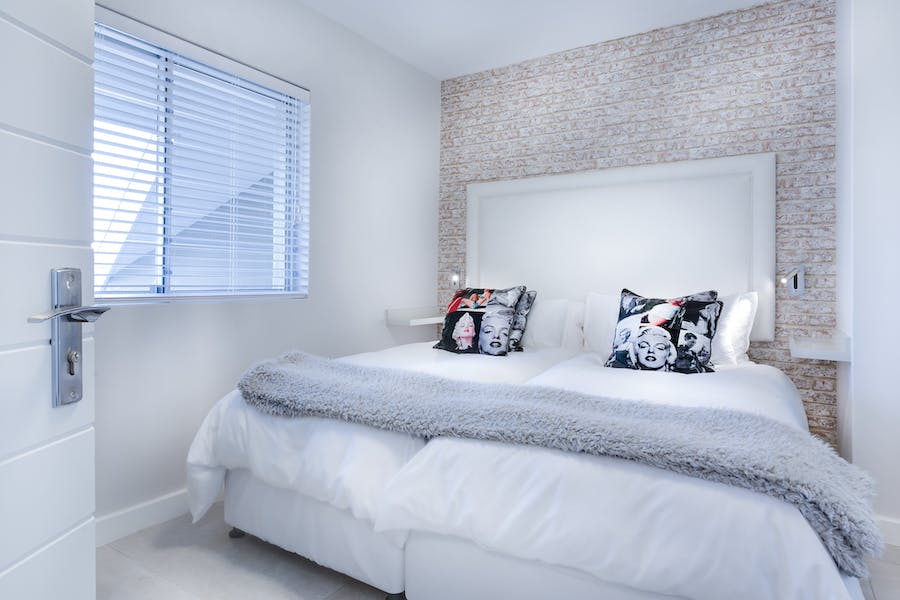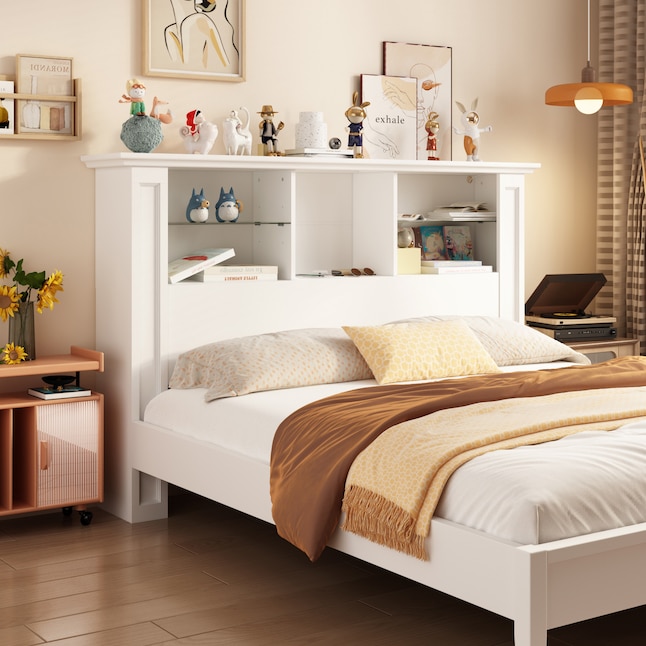
Secure a freestanding headboard by attaching it directly to the bed frame or anchoring it to the wall. Use sturdy brackets, screws, or wall mounts for a stable setup.
A freestanding headboard can transform the aesthetics of a bedroom, serving as a focal point while also providing support and comfort. As such, ensuring its stability is crucial not just for aesthetic purposes but for safety as well. Many headboards are designed with the capacity to stand on their own or be attached to a bed frame.
Carefully selecting the appropriate hardware is essential to prevent wobbling or potential accidents. Opt for high-quality fasteners and mounts to guarantee a solid, long-lasting hold, and always follow the manufacturer’s instructions for secure installation. Ensuring your headboard is immobile not only improves the comfort of your bed but also enhances the overall safety and integrity of your sleeping area.
Introduction To Freestanding Headboards
Freestanding headboards are a popular choice for bedroom aesthetics and functionality. These stylish pieces stand on their own, without the need to attach to a bed frame. They allow for simple room transformations. A variety of designs cater to diverse tastes. Freestanding options provide versatility in adjusting the bedroom layout. You can easily change themes or switch positions. They add character without permanent fixtures.
Popularity Of Freestanding Headboards
The allure of freestanding headboards lies in their ease of installation and flexible design choices. Sleek lines and rich colors mark contemporary styles. Classic wooden structures offer timeless appeal. Upholstered options bring softness and warmth. Freestanding designs are also ideal for renters. They keep walls damage-free. Portable and trend-setting, these headboards elevate room decor.
- Ease of setup
- Vast design selection
- Renters appreciate the no-damage installation
Importance Of Stability And Safety
While aesthetics drive the choice, safety and stability are paramount. A secure freestanding headboard ensures a worry-free environment. Proper stability prevents tipping and accidents. It provides peace of mind. Choosing the right method secures the headboard. It protects both the furniture and the users. Focus on the headboard’s base. Ensure it’s on a flat surface. Check the material’s durability. Prioritize these factors for a sound, stable experience.
- Ensure a flat, even base
- Check material quality for durability
- Prioritize safety in positioning the headboard

Credit: www.lowes.com
Choosing The Right Headboard
When setting up your bedroom, selecting the perfect headboard can add style and stability. A suitable headboard not only complements your room’s aesthetic but is essential for a good night’s sleep. Let’s explore how to make the best choice.
Material Considerations
Headboard materials impact both looks and longevity. Each material offers unique benefits. Here’s a brief rundown:
- Wood: Delivers classic charm. It’s sturdy and often heavy, ensuring solidity.
- Metal: Provides a sleek, modern appearance. It’s typically lighter and durable.
- Upholstered: Offers comfort and a soft touch. It comes in various fabrics and colors.
Choose a material that matches your bedroom’s theme and your personal preferences for maintenance and feel.
Matching Headboard With Bed Frame
Compatibility between the headboard and your bed frame is crucial. Here’s a simple guide:
| Headboard Type | Compatible Bed Frame |
|---|---|
| Wooden Headboard | Wooden or metal frame with headboard brackets |
| Metal Headboard | Any frame with matching fixing points |
| Upholstered Headboard | Platform or divan beds with headboard space |
Ensure the headboard fits adequately and is the right height for your frame. Always measure before purchasing.
Preparation For Installation
Getting ready to install your freestanding headboard? A successful setup begins with proper preparation. Follow these steps to ensure your headboard is secured safely and stylishly to enhance your bedroom’s ambiance.
Tools And Materials Needed
Gather the right tools and materials before starting. This ensures a smooth installation process. Needed items include:
- Drill
- Drill bits
- Screwdriver
- Level
- Stud finder (if attaching to wall)
- Wrench
- Mounting brackets or flush mounts
- Screws and bolts (appropriate size)
- Headboard
- Tape measure
- Pencil (for marking)
Measuring And Alignment
Measuring is crucial to align your headboard perfectly. Use your tape measure to find the center of the bed. This is where the headboard will sit. Now, measure the height at which you’ll place the headboard. Mark these spots with your pencil.
With the level, draw a line across the wall. This is your alignment guide. It ensures the headboard ends up straight and not tilted. If attaching your headboard to the wall, find and mark the studs for secure mounting. If your headboard is floor-standing, align it with the bed’s center and proceed with the bracket installation.
| Step | Action | Note |
|---|---|---|
| 1 | Find bed’s center | Headboard’s position |
| 2 | Measure headboard height | Mark with pencil |
| 3 | Draw level line across | Ensure straight placement |
| 4 | Locate and mark studs | For wall-mounted headboards |
:max_bytes(150000):strip_icc()/DIYWoodHeadboard-a5a74f30db6c48d1b163fcb3736caab2.jpg)
Credit: www.thespruce.com
Securing The Headboard To The Wall
Securing a freestanding headboard to the wall is vital for both safety and aesthetics. A well-attached headboard can transform a bedroom, bringing both style and stability. Follow these steps to ensure your headboard stands solid and beautiful behind your bed.
Mounting Brackets Installation
Mounting brackets are key to securing a headboard. Choose brackets designed for your headboard’s weight and wall type.
- Locate the studs in your wall using a stud finder.
- Mark the stud locations with a pencil.
Align the brackets with the marked studs. Ensure they are at the correct height for your headboard.
- Drill pilot holes into the studs.
- Screw the brackets onto the wall.
Attach your headboard to the wall brackets. Check for any movement to confirm a secure attachment.
Ensuring Level And Secure Attachment
For safety and symmetry, a level headboard is essential. Use a level tool to check the alignment.
| Step | Action |
|---|---|
| 1 | Place the level tool on top of the headboard. |
| 2 | Adjust until the bubble indicates a balanced position. |
Once level, double-check all connections. Tighten any loose screws and ensure the brackets hold firm.
- Examine each point where the headboard and wall meet.
- Secure any gaps with additional hardware if needed.
A solid headboard means peaceful nights and a polished room.
Attaching To The Bed Frame
Securing your freestanding headboard to the bed frame isn’t just about aesthetics. It ensures safety and stability. Two popular methods are bolt-on and hook-on. Each has its benefits, offering a sturdy solution to keep the headboard in place. Let’s explore both so you can decide the best fit for your bed.
Bolt-on And Hook-on Methods
Bolt-on and hook-on are the main ways to attach a headboard to a bed frame. Choose one depending on your headboard and bed frame type.
- Bolt-on involves using screws and bolts.
- Hook-on attaches with hooks that slide into slots on the bed frame.
For a bolt-on headboard:
- Align the headboard holes with the frame.
- Insert the bolts through.
- Tighten them with nuts.
A hook-on headboard requires:
- Line up the hooks with the pins on the frame.
- Slide the headboard onto the pins.
Either method ensures your headboard stays put. Check compatibility before purchasing hardware.
Final Adjustments For Stability
After attaching your headboard, ensure it’s stable.
This might involve:
- Checking all connections are tight.
- Making sure the headboard doesn’t wobble.
For extra support, consider adding brackets or wall mounts. These secure the headboard directly to the wall, providing another layer of stability. Finally, test the setup by gently pushing the headboard at various points. It should remain immovable. Enjoy a safe and secure headboard that complements your bed wonderfully, offering both function and style.

Credit: www.amazon.com
Additional Safety Measures
After securing your freestanding headboard, it’s crucial to keep it safe. Additional steps ensure it stays firmly in place. Kids and pets often bump into furniture. Making your headboard extra secure keeps everyone safe.
Regular Maintenance Checks
Perform routine checks to ensure your headboard remains stable. Over time, fittings can loosen. Monthly checks are a good rule. Begin by gently wiggling the headboard to test for movement. Tighten any loose fittings you find. Check for signs of wear on attachments and the wall behind the headboard. It’s also a good time to check the structural integrity of the headboard itself.
Avoiding Common Mistakes
When ensuring the safety of a freestanding headboard, sidestep these pitfalls:
- Ignoring manufacturer’s instructions can lead to improper installation.
- Using inadequate tools or hardware may result in a weak setup.
- Forgetting to measure the space behind the bed makes for a bad fit.
- Never overlook the importance of checking weight limits.
Correct these mistakes to keep your headboard secure. A sturdy setup means a safer room.
Frequently Asked Questions Of How To Secure A Freestanding Headboard
How Do You Attach A Headboard To A Bed Frame Without Holes?
To attach a headboard to a bed frame without holes, use adjustable brackets or universal headboard adapters. Secure brackets to the headboard, then to the bed frame. Alternatively, mount the headboard to the wall behind the bed for stability.
Can You Make A Headboard Free Standing?
Yes, you can create a free-standing headboard using a sturdy frame or legs attached directly to the headboard for support.
How Does A Freestanding Headboard Work?
A freestanding headboard stands independently behind a bed without attachment, often positioned between the bed and the wall for stability. It’s a versatile, movable alternative to fixed headboards.
How Do You Secure A Free Standing Headboard To The Wall?
To secure a free-standing headboard, locate wall studs, position the headboard, mark drill points, drill pilot holes, and attach using appropriate screws.
Conclusion
Securing your freestanding headboard can transform your bedroom’s look and feel. With the easy steps we’ve outlined, achieving stability and style is within reach. Remember, a firmly anchored headboard is not just about aesthetics; it’s a safety staple. Dive into this DIY project and enjoy a snug, serene sleeping space.




















